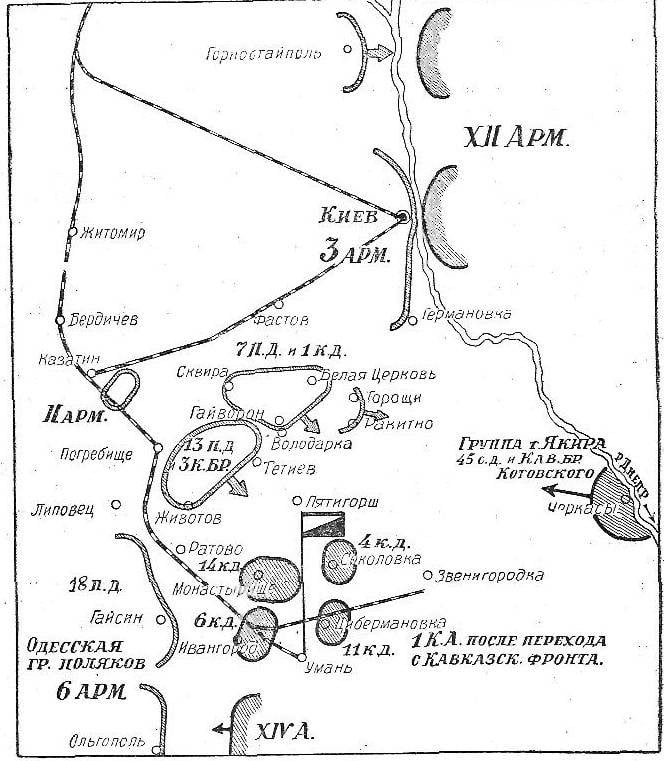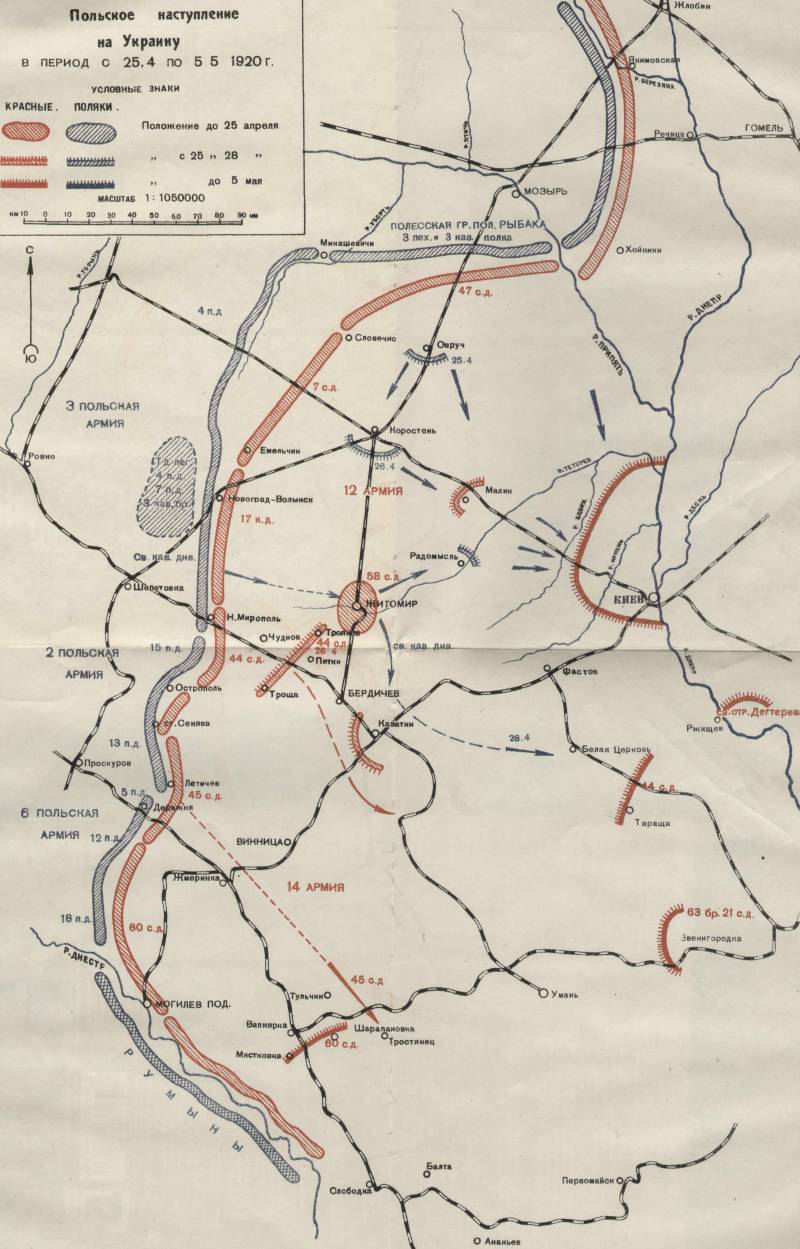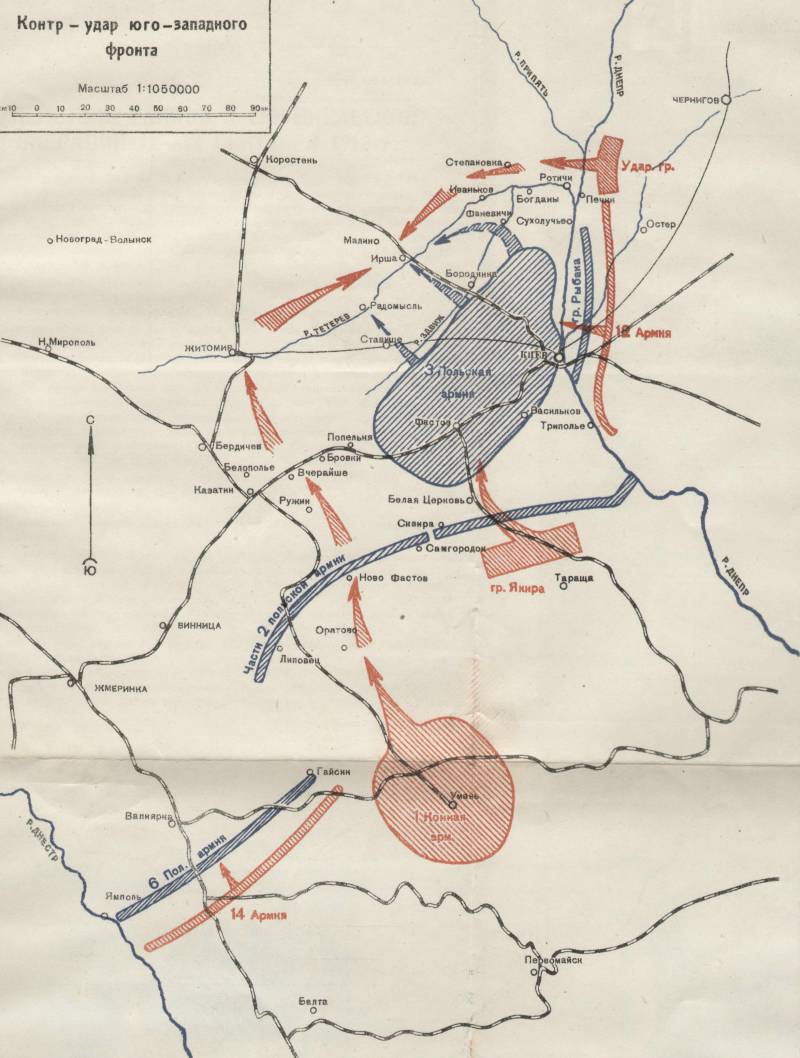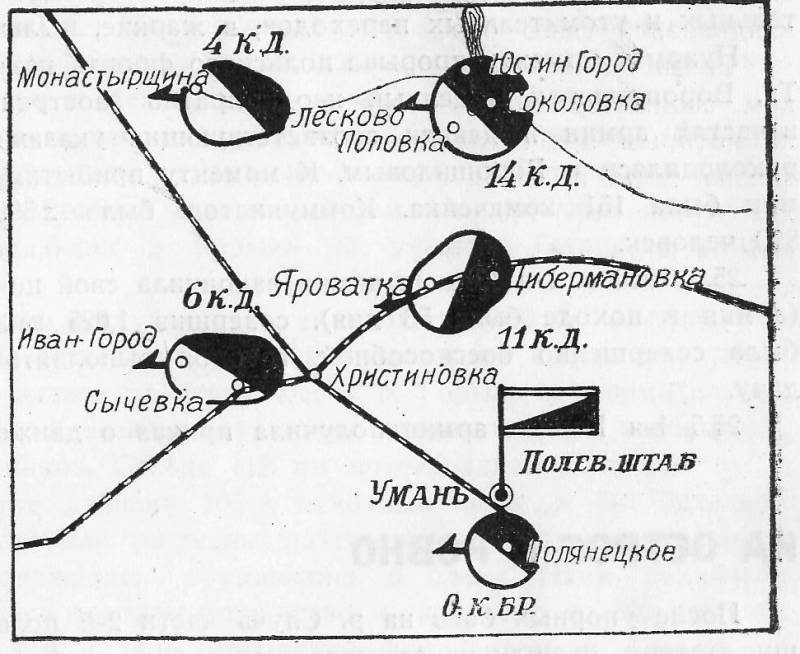Kiev battle. 1920
22 April 1920 (three days before the start of the Polish invasion of Ukraine) an agreement was concluded between J. Pilsudski and the head of the Ukrainian nationalists S. Petliura: Poland recognized the "independence" of the UNR and assumed the obligation to "liberate" Ukrainian territory.
The main provisions of the plan Yu. Pilsudski:
1) war must be quick; 2) a lightning strike should defeat the Soviet South-Western Front, seize Kiev and establish itself within the boundaries of 1772; 3) after crushing the Red Army in Ukraine, castling the main forces of the Polish army to the north in order to attack the Red forces in Belarus. The campaign was supposed to take a maximum of 10 - 12 weeks. From February 1920 began the concentration of large Polish forces - 3 cavalry and 9,5 infantry divisions on the 400-kilometer front of the river. Clean, Novograd-Volynsky, Kamenets-Podolsky.
The enemy was opposed by two red armies: 12-I, which covered the Kiev operational direction, and 14-I, which provided the operational direction to Odessa. Their number and material resources were insufficient. The rifle divisions were in great deficiency. For example, the 47 Rifle Division, which was part of the 12 Army, had only 892 bayonets and 72 sabers; there were divisions in an even more depleted state (for example, 58). In general, the strength of the troops of the South-Western Front was more than four times lower than that of the enemy.
12-I army held positions on the river. Pripyat (m. Dernovichi), Novograd-Volynsky, Ostropol; 14-I army - Letichev, Mogilev, Slobidka. Due to the need to defend very stretched combat areas, the armies were ordered to act in accordance with the method of active defense - covering the front line with relatively small forces, concentrating the necessary reserves in the attack groups.
25 April, a wave of Polish offensive surged across Right Bank Ukraine. The main blow the Poles inflicted on 12-th army, defending the approaches to Kiev. On the front of this army, the Polish 3-I army, consisting of two strike groups, acted. The Polish 2 Army, advancing south of the 3, launched an auxiliary strike in the direction of Fastov, bypassing the left flank of the 12 Army. In the south, in the Odessa direction, the enemy opposed his 14 army to the red 6 of the army.
Yu. Pilsudski considered the immediate task of the encirclement and defeat of the 12 army.
Il 1. Polish offensive in Ukraine during the defensive phase of the operation.
Yielding to the enemy in numbers and material resources, but hardened in prolonged combat trials, Soviet troops with rearguard battles retreated in the Kiev direction. On May 6, the city of Kiev was left red, and the soldiers of the 12 Army retreated to the left bank of the Dnieper. Three days later, the enemy also captured a bridgehead there - in front of Kiev.
After the seizure of Kiev, the scope of the Polish offensive stopped, and the Poles moved to active defense. The situation on the front of the 14 Army was similar. The Polish offensive in Ukraine, having reached its maximum swing by May 10, began to weaken.
The strategic tasks set by J. Pilsudski were not fulfilled by the Polish armies. The backbone of the 12 Army, entrenched at the turn of the river. The Dnieper, continued to shackle the superior forces of the Polish 3-th army near Kiev. The 14 Army managed not only to get out from under the powerful blows of Polish troops brought over it, but in the Gaisin-Vapnyarka area occupied a flank position that seriously threatened the Polish 2 Army if the latter continued its attack to the east.
The Polish group dispersed like a fan in two directions - Kiev and Odessa, as a result of which its shock force dissolved in space. Poles began to experience interruptions in supply.
By 15 May, the composition of the Polish 3 Army - 14805 bayonets and sabers, 282 machine guns and 96 guns. The main task of the army is the active defense of Kiev. The composition of the Polish 2 Army - 17813 bayonets and sabers, 343 machine guns, 105 guns. The main combat task is to cover the Kazatinsky direction.
Further south against the red 14 Army units was the Polish 6 Army, which had 13000 bayonets and sabers, 404 machine guns and 114 guns. The army was supposed to attack Odessa.
With reserves, the Polish grouping consisted of 40468 bayonets, 6050 sabers, 1101 machine guns, 280 light and 55 heavy guns.
In the current operational-tactical situation, the Soviet command decided to implement a counter-maneuver, the main task of which was to surround and defeat the Polish 3 Army defending the Kiev region, followed by the defeat of the entire Polish front in Ukraine. The start date of the counteroffensive depended on the regrouping of forces and assets and on the arrival of the 1 Cavalry Army S. M. Budenny, on April 20 speaking from the North Caucasus in a thousand-kilometer march. 18 May its main forces in the 18000 sabers, 362 machine guns, 48 guns, 8 armored vehicles, 15 aircraft, 5 armored trains were already on the right bank of the Dnieper and approached Elisavetgrad.
At this point, the 12 Army was concentrated on the right flank of the front (as part of the army, including the 25 Infantry Division, there were 18184 bayonets and sabers, 460 machine guns, 72 guns), a group of I. Ye. Yakir was standing south of the 12 Army. (4036 bayonets and sabers, 315 machine guns and 43 guns). On the left flank of the front was still the 14 Army (6352 bayonets and sabers, 293 machine guns and 77 guns).
Thus, the combat force of the front, even with the approach of the 1 th Cavalry Army and the 25 th Infantry Division, was numerically inferior to the Poles.
The counter-maneuver plan provided for the organization of four attack groups of unequal power: 1) the Kiev group (2 rifle divisions and the cavalry brigade of the 12 army); 2) Fastovskaya group (2 rifle divisions and a cavalry brigade from the group of E. E. Yakir); 3) Kazatinskaya Group (which included the 1 Cavalry Army in its membership); 4) Zhmerinskaya group (it included the 14-I army), which had the task to chain the enemy.
The main objective of the counter-maneuver was to encircle and defeat the Polish 3 Army - with the help of deep strikes in converging directions.
Il 2. Counter-strike of the South-Western Front.
Yielding to the enemy in numbers, the front command provided more than double superiority over enemy forces in the area of the main attack.
The operation began on 26 May.
It was important for the Poles to maintain their positions until the end of the decisive battle on the Lithuanian-Belarusian front. Therefore, all the actions of the Poles were distinguished by their exceptional stubbornness - combining defenses with counterattacks, they managed to engage in protracted positional battles with the Soviet strike groups. Under these conditions, the resolution of the crisis of the operation depended on the outcome of the breakthrough of the Cavalry Army - the main shock force of the front.
Il 3. Concentration of the 1 Cavalry Army on the South-Western Front.
But during the first three days of the battle, the operational unit was involved in battles with large gangster detachments of the ataman Kurovsky in the Pyatigorsk region, and Oratovo in front of the Polish 2 Army.
By the evening of May 28, these formations, which had fighters with machine guns before 15000, were finally defeated, and the path to the Polish front was cleared.
By the evening of May 29, the Cavalry Army advanced to the line of Samgorodok, Novo-Fastov, Lipovets, where they were forced to engage in frontal battles with the Polish 13 Infantry Division. The front of this division was a well-camouflaged and fortified section of the terrain, reinforced by rubble and wire obstacles. The defense zone of the 13 division reached depths of up to 6 - 8 km, having a number of strong resistance nodes.
Protracted battles of the red cavalry with the enemy infantry in the fortified area, were not included in the calculations of the Soviet front and army command - the cavalry needed to escape to the operational space. Therefore, 3 June, the front command issued an order to the 1 th Cavalry Army: break through on the right flank of the 13 th infantry division in the Pustovarovka combat area, Novo-Fastov - at the junction of the Polish 3 and 2 th armies, covered only by cavalry.
It was here that June 5 and the first episode of the famous combat drama broke out, culminating in great success: the breakthrough of the army of soldiers in the Kazatin direction.

Il 4. The situation at the time of the breakthrough of the Polish front.
Thanks to the equestrian breakthrough, the strategic situation was drastically changed. At the same time, the strike force of the 12 Army (Bashkir Cavalry Brigade, troops of the 7 and 25 rifle divisions), crossing the Dnieper, seized a bridgehead on the right bank.
Thus, the 5 of June began to reveal the contours of the covering counter-maneuver of Soviet troops.
The rapid advance of the 1 Cavalry Army continued the next day. She energetically developed a breakthrough to the north-west and entered the Kiev-Kazatin railway line.
As a result, by the end of June 6, the Cavalry Army held a threatening position in relation to the rear of the Polish 3 Army, being in close proximity to the three most important strategic centers of Ukraine: Kazatin, Berdichev and Zhytomyr.
But after the front was breached, the 13 Infantry Division of the Poles launched an offensive in the northeast direction and re-established a solid front with the troops of the Polish 3 Army.
And in the evening of June 6, the Polish front closed behind the Cavalry Army.
But, in fact, having encircled the army, the command of the army was not lost, and outlined two blows: to Zhytomyr and to Berdichev. The headquarters of the commander of the Polish Ukrainian Front and the main base of the Polish 3 Army were in Zhytomyr - the blow delivered in this direction disorganized the control of the Polish Ukrainian Front.
On the morning of June 7, quite suddenly for the Poles, the 4-I cavalry division seized the city of Zhytomyr. The headquarters of the Ukrainian front of the enemy managed to get out of the city and fled in the direction of Novograd-Volynsky.
On the same day, after a stubborn battle, the 11 Cavalry Division captured the city of Berdichev. Having blown up a large ammunition depot at the railway station, on the night of June 8, she moved north-east of the city.
After that, the Commander of the Cavalry Army again gathered his divisions into a powerful shock fist.
At this time, the shock group of the 12 Army continued to expand its right bank bridgehead. But the group of E.E. Yakira was involved in heavy fighting with the Polish 7 Infantry Division and with the so-called Vasilkovsky detachment south of Belaya Tserkov.
To reverse the unfavorable development of the situation, Yu. Pilsudsky decided to organize a risky maneuver, which was based on the idea of attacking converging directions in the Zhytomyr region in order to surround and defeat the 1 Cavalry Army. But the increasingly tense military situation for the Polish forces influenced the change and cancellation of this plan.
8-9 June main events of the operation continued to develop at the two extreme points of the Polish 3 Army Front: 1) on the left flank of this operational association, the 12 Army attack group continued to develop an offensive bypassing flank, threatening to cut the Kiev-Korosten road; 2) on the right flank of the Polish 3 Army 8 of June, a group of E. E. Yakira captured the city of Skvira and reached the line Kagarlyk, Vincentovka, Zhitnye Gory, Cherkasy.
At the same time, units of the Cavalry Army were moved towards the group of I. Yakir from the Khodorki region on Fastov, which facilitated the seizure by a group of this city the next day.
Thus, on both flanks of the Polish 3 Army by the end of June 9, a covering maneuver of the Soviet troops showed up in relief. Kiev district has lost rail links with Poland.
Under these conditions, the commander of the Polish 3 Army, General Rydz Smigly, disobeyed the order of his commander-in-chief and decided to withdraw the army not to Zhytomyr, but to Korosten. The start date of the retreat is 24 hours 10 June.
Moreover, by the beginning of the withdrawal, the operational situation seemed so alarming to the Polish commander that the general even gave an order to which he allowed his troops to destroy material and military equipment.
By June 12, the 12 Army Shock Group intercepted the retreating units of the enemy’s right and middle groups, while the 1 Cavalry Army 12 June occupied the Zhytomyr region, heavily patting the 7 Infantry Division. Fighting on the outskirts of Korostenu ended the Kiev operation. 15 June was given front-line directive on the pursuit of the enemy.
Having started a retreat, the Polish armies continued it to the city of Lviv.
The battle of Kiev underlined the great importance of the presence of large cavalry masses, free reserves and communications in a war of maneuver.
The 1-I Cavalry Army, which had been active for more than 20 days, was a support and cover for the infantry units advancing behind it. In no other operation of the Soviet-Polish war was the active use of cavalry carried out in such diverse forms as in the battles of the Kiev operation. The experience of this operation demonstrated the desirability of including strategic cavalry rifle formations in the grouping to cover and defend captured areas and free cavalry to continue a deep maneuver.
But in the matter of the availability of free reserves, the South-Western Front was at a disadvantage. The lack of the necessary forces did not allow the front command to adequately strengthen the combined-arms strike groups and increase their combat power before the interchange of the operation.
The battle of Kiev is a turning point in the Soviet-Polish war. It was the Kiev breakthrough that led to the massive surrender and desertion of enemy soldiers and officers. The operation was crucial for the outcome of the Soviet-Polish confrontation.



Information